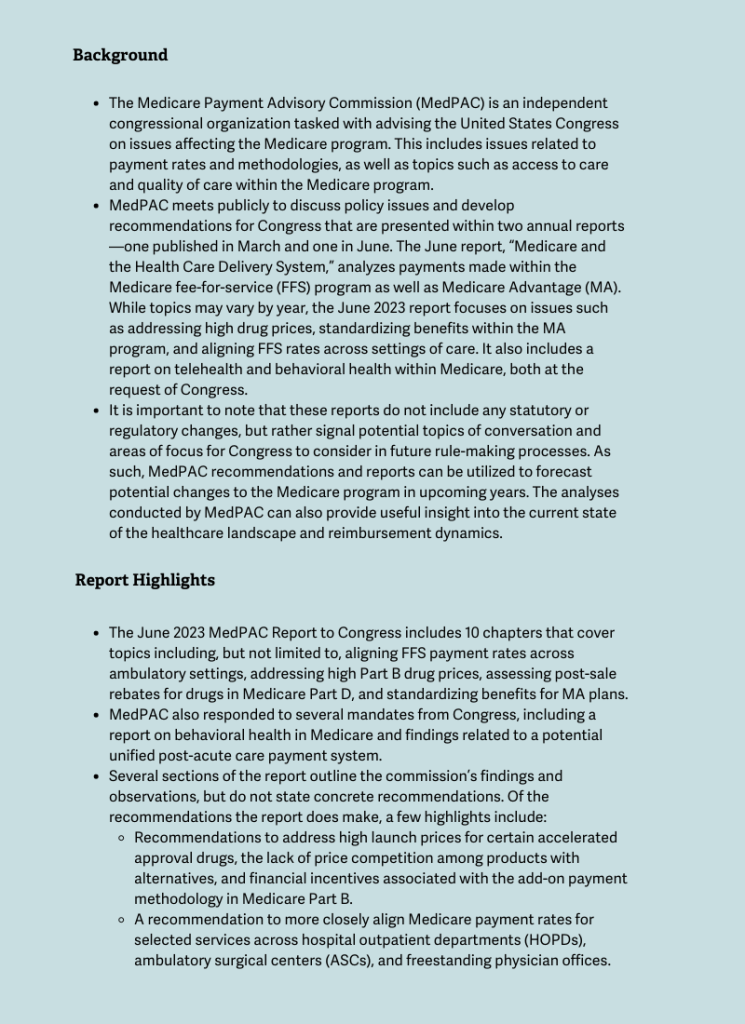
Background and Report Highlights

Summary of Key Chapters
Alignment of Medicare Payment Systems
Ambulatory Care
MedPAC recommended that Congress move toward reducing or eliminating differentials in payment levels across HOPDs, ASCs, and freestanding physician offices for services that can be safely and appropriately provided in less acute settings of care.
Background
- The commission noted that payment differentials encourage various provider arrangements, including consolidation of physician practices with hospitals, which in turn leads to care being provided in higher-cost settings. For example, from 2015 to 2021, chemotherapy administration volume in lower-cost office settings fell 14.2% while volume in higher-cost HOPDs grew 21.0%.
- MedPAC concluded that aligning payment rates for appropriate services across settings will reduce spending, lower beneficiary cost sharing, and incentivize providers to improve efficiency.
Recommendations
- MedPAC recommended more closely aligning rates across ambulatory settings for services deemed safe and appropriate to provide in all settings. Rate adjustments for eligible services would be based on the rate paid to the ambulatory setting with the largest volume of the respective service.
- For example, if the largest volume of a service is provided at physician offices, the rate paid at ASCs and HOPDs would be lowered to the rate paid at physician offices. If the largest volume is provided at ASCs, no adjustments would be made to the lower-cost physician offices, but the HOPD rate would be lowered to that of ASCs.
- MedPAC noted that the recommendation would have no immediate effect on total Medicare revenue for OPPS hospitals in aggregate, but over time, may indirectly affect spending as incentives shift. The financial impact to individual hospitals would also vary.
Post-Acute Care (Mandated Report)
MedPAC issued a report mandated by Congress on a potential unified payment system that would align payment rates across various post-acute care settings. MedPAC reported that the design of a system is feasible but would be difficult to implement, and thus recommended policymakers consider smaller-scale policies prior to contemplating implementation of a fully unified system.
Background
- The commission was mandated by the IMPACT Act of 2014 to evaluate a prototype design for a uniform post-acute care prospective payment system (PAC PPS) that would span skilled nursing facilities (SNFs), home health agencies (HHAs), inpatient rehabilitation facilities (IRFs), and long-term care hospitals (LTCHs).
- MedPAC noted that previous analysis on this topic showed that the payment design was feasible and should include key features such as: 1) basing payment on the PAC stay (not an episode of PAC), 2) creating a common risk-adjustment system (to include patient functional status), and 3) aligning on uniform short- and long-stay and high-cost outlier policies. MedPAC also noted the need for an adjustment for home health stays to avoid overpayment for less costly home healthcare and underpayment for care in an institutional setting.
- While MedPAC believes a PAC PPS is feasible, the transition costs and policies needed to support and create alignment during the implementation pose significant barriers. The commission noted that the changes could be controversial, costly, and take many years to implement.
Recommendations
- Given the barriers to a uniform PAC PPS and the wide variation of impact to providers, MedPAC recommended that policymakers consider smaller-scale, site-neutral policies that could address overlap of similar patients in different settings prior to implementing a fully unified system.
- The commission also reiterated prior recommendations that Congress should lower base payment rates for HHAs, SNFs, and IRFs.
Recommendations to Contain Medicare Part B and D Drug Spending
Within the June 2023 report, MedPAC put forth recommendations to help stem the growth of Part B and Part D drug spending. Specifically, the commission made recommendations for addressing high launch prices for accelerated approval drugs with unconfirmed benefits, spurring price competition for high-cost drugs, and assessing the impact of Part D post-sale rebates.
Medicare Part B
Background
- Medicare Part B covers prescription drugs administered by infusion or injection in physician offices and HOPDs. Part B drug expenditures have increased substantially in recent years, growing at an average rate of 9% per year between 2009 and 2021 and reaching $43 billion in spending by 2021.
- MedPAC noted two major drivers of increasing cost in the Part B program:
- The accelerated approval pathway, which allows drugs to come to market with intermediate approval from the Food and Drug Administration (FDA) based on a reasonable likeliness to produce clinical benefit. Manufacturers often set these drugs at very high prices, even before their clinical benefit is proven.
- The current average sales price (ASP) payment system, which the commission noted serves to maximize price competition among generic drugs and brand products through use of a single billing code. However, high-cost drugs and biologics that are assigned their own billing codes lack the incentive for price competition, and thus contribute to rising drug spend. Within the ASP system, MedPAC also noted that the percentage add-on for drug payments under Medicare Part B (i.e., ASP + 6%) may create incentives for use of higher-priced drugs, as the add-on will generate more revenue when applied to a higher-priced product compared to a lower-cost product.
Recommendations
- For drugs approved under the accelerated pathway,MedPAC noted that processes are needed to ensure that Medicare does not overpay for these products. The commission also discussed that manufacturer incentives must be created to ensure completion of confirmatory trials.
- As a result, the commission recommended that Congress require the Secretary of the Department of Health & Human Services (HHS) to cap Medicare payment rates for Part B drugs and biologics that are approved under the accelerated approval program if:
- Post-marketing confirmatory studies are not completed within the established deadline.
- The product’s clinical benefit is not confirmed in post-marketing studies.
- The product is covered under a “coverage with evidence development” policy.
- As a result, the commission recommended that Congress require the Secretary of the Department of Health & Human Services (HHS) to cap Medicare payment rates for Part B drugs and biologics that are approved under the accelerated approval program if:
- To promote price competition, the commission recommended Congress give the secretary the authority to establish a single ASP base payment rate for groups of drugs and biologics with similar health effects. The commission also recommended an approach to minimize the relationship between ASP and add-on payments to improve financial incentives. This included a recommendation to reduce or eliminate the add-on payment amount for costly drugs.The commission also recommended that the secretary be authorized to cap Medicare payment rates for accelerated approval Part B drugs if the price is excessive relative to the upper-bound estimates of value.
Medicare Part D
Background
- Medicare Part D is a prescription drug benefit offered by private insurers that beneficiaries purchase as a supplement their traditional Medicare or MA plan. Insurers and their pharmacy benefit managers (PBMs) negotiate rebates from drug manufacturers and pharmacies that are paid to insurers after the drug has been dispensed. Between 2010 and 2021, these rebates (or post-sale rebates) have increased from $8.6 billion to $62.7 billion, and now account for 29% of Part D spending (up from 11% in 2010).
- Part D drug rebates have become a significant revenue source for Part D plans, which is creating incentives to steer usage of high-price drugs, thus allowing plans to maximize rebates while bearing little risk or financial exposure to the rising drug costs.
- In addition, since the rebates occur after drugs have been dispensed, the value of the rebates is disproportionately realized by plan sponsors and less so by Medicare beneficiaries (by way of lower cost shares).
- MedPAC also noted the growing trend of vertical integration between Part D plans, PBMs, and pharmacies. The larger market share of enrollment gives plan sponsors more bargaining power for post-sale rebates from most manufacturers and pharmacies.
Recommendations
The commission did not make any specific recommendations related to Part D drugs.
Medicare Advantage Benefits and Payments
MedPAC found that the number and variation of plans and benefits within MA have grown substantially in recent years, creating challenges for beneficiaries when deciding on a plan that best meets their needs. The commission outlined a potential approach to standardizing MA benefits. Meanwhile, overall growth in MA enrollment has raised questions about favorable selection and the appropriateness of the current MA payment model.
Benefit Plans
Background
- Over the past five years, the average number of MA benefit plans available to beneficiaries in a given market has more than doubled, increasing from 20 to 41. The increase in plan offerings is being driven by several factors, including new market entrants and regulatory changes that have made it easier for carriers to offer numerous plans.
- Selecting the right plan can be difficult because there are so many variables to consider, including premium, cost shares, supplemental benefits, drug coverage, and provider networks. The commission cited studies showing that as the number of plan choices increases, consumers are less likely to correctly identify the most appropriate plan.
Recommendations
- The commission did not make any concrete or formal recommendations to Congress related to MA benefits but did offer various ideas and approaches for consideration.
- The commission acknowledged the need for policymakers to simplify benefits while continuing to let plans design their own benefits. One solution the commission proposed was to standardize dental, hearing, vision, and/or the more common supplemental benefits. The commission cited the Medigap and exchange markets as example programs that have implemented standardized benefits.
Payment Policy
Background
- The commission noted that payments to MA plans are systematically greater than plans’ spending for their enrollees—largely due to risk scores that consistently overpredict MA enrollees’ actual spending. MedPAC found that this is, in part, driven by favorable selection of beneficiaries who choose to enroll in MA plans rather than traditional FFS Medicare. Additionally, MA benchmarks—which drive payments—are based exclusively on Medicare FFS spending data.
- The report noted that MA enrollees’ spending in 2019 was 11% less than spending of FFS beneficiaries with the same risk scores.
- The commission raised additional concerns related to these issues, including the following:
- Overpayments to MA plans are at the expense of taxpayers and beneficiaries, and are ultimately felt through higher Part B premiums.
- Favorable selection for MA plans makes it challenging to assess how efficient MA plans are when compared to FFS.
- As more beneficiaries shift from traditional Medicare to MA plans, the Medicare FFS data will become less reliable when setting benchmarks for the entire Medicare market.
Recommendations
- The commission did not make any concrete or formal recommendations to Congress related to the MA payment model but did offer various ideas and approaches for consideration.
- The commission suggested using an approach that does not rely solely on FFS spending. Among the options noted by the commission were using a competitive bidding system to determine benchmarks, creating benchmarks using both MA and FFS spending, and setting benchmarks based on a point in time and then updating them periodically.
Behavioral Health Congressional Request
In January 2022, the Chairman of the House Committee on Ways and Means requested that MedPAC analyze the utilization and availability of behavioral health services within the Medicare program. In response, the June 2023 report addresses two main topics related to behavioral health: 1) utilization and spending on behavioral health services within the FFS program (clinician and outpatient services), and 2) trends and issues related to inpatient psychiatric care and the associated payment system. As a congressional request, this aspect of the commission’s report focuses on the current state and does not make any specific recommendations.
Clinician and Outpatient Services
Utilization and Spending
- MedPAC’s analysis of clinician and outpatient care included services such as psychiatric evaluations, psychotherapy, opioid treatment, and other care provided under Medicare Part B for FFS beneficiaries.
- The commission found that in 2021, 4.9 billion Medicare FFS beneficiaries—or 16% of total beneficiaries—received outpatient behavioral health services. These beneficiaries were more likely to be disabled, low income, and younger than FFS beneficiaries who did not utilize behavioral health services. Healthcare spending (including for prescription medications) was almost twice as high for these beneficiaries compared to the average spend for all Medicare FFS beneficiaries.
- MedPAC found that over 30% of beneficiaries who utilized behavioral health services only received one visit, a signal that follow-up care may be lacking in the space.
- Of note, less than 1% of beneficiaries who utilized behavioral health services in 2021 received behavioral health integration services (i.e., the implementation of a multidisciplinary team-based approach to primary care). This is likely to become an area of focus, as integration of behavioral and primary care is a key component of HHS’s strategy to address the mental health crisis.
- In 2021, the top three behavioral health conditions were: 1) depression, 2) anxiety, and 3) substance use disorders (SUDs). Of note, the number of beneficiaries receiving treatment for opioid use disorders (OUDs) increased an estimated 7% annually between 2019 and 2021, while the number of beneficiaries treated for alcohol use and other SUDs declined during that period. Enrollment in Medicare’s opioid treatment program also increased roughly 27% between the program’s introduction in 2020 and 2021.
- Based on submitted encounter data, MedPAC found that characteristics of, and utilization rates for, MA enrollees were similar to those of FFS beneficiaries.
Access
- MedPAC’s analysis on staffing found that 40% of clinicians who opted out of Medicare in 2022 were behavioral health clinicians. The opt-out rate among psychiatrists is the highest of all physician specialties in the Medicare program, at 7.2%.
- The commission noted that the psychiatrists who opted out were more likely to be older, female, graduates of top-20 medical schools, and practicing in areas with fewer psychiatrists per Medicare beneficiary.
- The commission noted that as the number of psychiatrists declined between 2016 and 2021, the volume of services provided by nurse practitioners increased substantially.
- Finally, MedPAC noted the growing role of primary care in behavioral health services, with the number of mental health concerns addressed during primary care visits increasing by nearly 50% between 2006 and 2018 according to one study.
Telehealth
- The commission found that while the COVID-19 pandemic exacerbated provider shortages, the rapid uptake of telehealth helped meet demand. Of note, the use of telehealth for behavioral health services continued to rise in 2021, even as use of other telehealth services declined in comparison to 2020.
- In analyzing utilization trends, MedPAC found that telehealth utilization within behavioral health was most common for psychotherapy services and that telehealth users had lower overall spending on Medicare Parts A and B services but filled more Part D prescription medications than their in-person-visit counterparts.
Inpatient Psychiatric Care
Utilization and Spending
- Medicare beneficiaries experiencing acute behavioral health crises can be treated in general acute care hospitals or specialized inpatient psychiatric facilities (IPFs). In FY 2021, 157,500 Medicare FFS beneficiaries had 230,500 stays, incurring a total spend of $3.0 billion.
- The commission found that Medicare beneficiaries utilizing IPF services are among the most vulnerable populations. Specifically, these beneficiaries are far more likely to be disabled, low income, have more chronic conditions, and utilize more healthcare services compared to the general Medicare population. In fact, Medicare Part A and Part B spending per beneficiary was nearly four times higher for beneficiaries with an IPF stay compared to those without. Part D spending for these beneficiaries was roughly twice as high.
Access
- MedPAC reported that despite a decline in the number of IPFs since 2017, the number of psychiatric beds has grown, driven by a rise in the number of beds at for-profit IPFs.
- Average occupancy rates also fell over this period, from 76% in 2017 to 70% in 2021. However, the commission noted that this finding was misaligned with IPF interviewees’ reports of labor shortages and a lack of available beds. This may be driven by disproportionately high occupancy rates at government IPFs, which suggests an insufficient supply of beds for persistently ill beneficiaries.
Recommendations
The behavioral health report was issued in response to a congressional request for analysis, so it does not include any specific recommendations. However, the request signals congressional focus on behavioral health. MedPAC’s findings may lead to a future request for recommendations or upcoming regulatory action around access to, and reimbursement for, behavioral health services.
Connect with our experts
Contact our Managed Care Services team if you want to discuss how this rule will affect your planning.
Edited by: Matt Maslin






